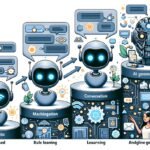As cities grow and change, the tools and technologies we use to plan and develop them must also evolve. Replica’s artificial intelligence (AI) represents a leap forward in this area, bringing new capabilities and insights to urban planning. This article will explore how Replica’s AI is making a significant impact, offering a glimpse into a future where our urban environments are more livable, efficient, and inclusive.
Understanding Replica’s AI Technology
Replica’s AI Revolutionizing Urban Planning
In the rapidly evolving city landscapes, urban planners are turning to cutting-edge tools to shape the future. Replica, a company utilizing artificial intelligence (AI), stands out by offering unparalleled insights into urban planning. This article breaks down what makes Replica’s AI a game-changer in designing our cities.
At the core of Replica’s technology is a sophisticated AI system that harnesses big data to simulate urban environments. Unlike traditional methods, which often rely on outdated or generalized data, Replica uses real-time information. This includes traffic patterns, public transit usage, and even pedestrian foot traffic. By analyzing this vast amount of data, Replica’s AI can create detailed models of urban areas.
What sets Replica apart is its focus on privacy and accuracy. The company employs advanced anonymization techniques to ensure individual data remains confidential, addressing one of the major concerns in using personal data for urban planning. Moreover, Replica’s models are impressively accurate, providing urban planners with a reliable basis for making decisions.
Replica’s AI also excels in flexibility. Urban planners can test various scenarios within the Replica platform. Want to know how a new subway line might affect commuter times across the city? Replica’s AI can simulate that. Curious about the impact of a new park on local businesses? Replica can model these outcomes as well. This ability to explore different futures gives city planners a powerful tool to forecast the implications of their decisions.
Collaboration is another key aspect of Replica’s success. The platform is designed to be user-friendly, enabling planners, city officials, and stakeholders to work together seamlessly. Through its intuitive interface, users can share insights, propose modifications, and collectively refine plans. This collaborative approach ensures that urban development benefits from a wide range of perspectives.
Finally, Replica’s AI is continuously learning. As cities change and new data becomes available, the AI updates its models. This means that urban planners have access to the most current information, allowing for adjustments to plans in response to evolving urban dynamics.
Replica is reshaping the field of urban planning with its AI. By leveraging real-time data, prioritizing privacy, offering flexibility in scenario planning, facilitating collaboration, and ensuring the continual learning of its AI, Replica provides an essential tool for creating more livable, efficient, and inclusive cities.

Replica’s Impact on Urban Planning
Replica, a cutting-edge technology company, is revolutionizing the way cities and urban areas are designed and reimagined. At its core, Replica’s mission is to provide urban planners, local governments, and policymakers with a comprehensive set of tools that offer unprecedented insights into how cities function on a day-to-day basis. This transformative approach to urban planning is facilitated through the sophisticated use of data analytics and machine learning algorithms, aspects that set Replica apart from traditional methodologies.
An essential component of Replica’s technology is its capacity to integrate and analyze vast datasets related to urban mobility and environmental factors. This analysis encompasses everything from traffic patterns and public transportation usage to pedestrian flow and green space distribution. By harnessing this data, Replica equips planners with the knowledge needed to make informed decisions that better serve the community’s needs and promote sustainable urban development.
Moreover, Replica’s platform stands out for its user-friendly interface, which simplifies the complexity of urban data. This aspect ensures that the insights gained are not just reserved for data scientists or IT professionals but are accessible to all stakeholders involved in the urban planning process. As a result, decision-making becomes more democratic, with community leaders and local residents having a say in shaping their environment.
Another noteworthy feature of Replica’s approach is its focus on sustainability. By providing detailed insights into carbon footprint, air quality, and resource allocation, Replica aids in the creation of greener, more sustainable urban spaces. This commitment to environmental stewardship is critical in an era where cities are grappling with the challenges of climate change and seeking ways to reduce their impact on the planet.
Replica also emphasizes the importance of adaptability in urban planning. Cities are living, breathing entities that continuously evolve. Replica’s technology acknowledges this by offering the ability to update and refine models as new data becomes available. This means urban plans are not static but can evolve alongside the city, ensuring that strategies remain relevant and effective over time.
In a world where urban areas are increasingly complex and interconnected, Replica’s innovative approach offers a beacon of hope. By leveraging advanced analytics and AI, Replica not only enhances the efficiency and effectiveness of urban planning but also fosters more resilient, inclusive, and sustainable communities. As cities continue to grow and change, technologies like Replica play a pivotal role in ensuring that this growth is managed intelligently and responsibly, for the benefit of all who call these urban landscapes home.

Data Privacy and Ethical Considerations
Exploring the Data Privacy and Ethical Implications of Using Replica’s AI
In the rapidly evolving urban landscape, Replica’s AI has carved a niche for itself by offering revolutionary insights into city planning and development. However, its innovation comes with an array of data privacy and ethical questions that demand our attention.
For starters, the foundation of Replica’s AI is the massive quantity of data it collects. This includes information about how people move around cities, where they spend their time, and the routes they prefer. While this data is crucial for creating accurate urban models, it raises significant privacy issues. The principal concern here is the potential for misuse of personal data. Despite assurances of anonymization, there’s a lingering question about how anonymous this data truly is. With today’s technology, anonymized data can sometimes be re-identified, posing a threat to individual privacy.
Moreover, the ethical implications of data collection extend beyond privacy. There’s a broader question of consent. Do individuals know that their data is being collected and used for urban planning? And even if there’s a form of consent, is it genuinely informed? These questions highlight the need for transparent communication between technology providers like Replica and the general public.
Another ethical consideration involves the accuracy of Replica’s models. While these models are built with the best intentions, relying on AI-generated predictions can lead to decisions that may not always reflect the needs or desires of all city residents. This reliance can inadvertently sideline certain groups, particularly those whose behavior might not be as well-represented in the data. This brings us to the issue of equity – ensuring that urban planning decisions benefit everyone, not just the majority or those most easy to analyze.
Data privacy also intersects with security. The vast databases Replica uses are a potential target for cybersecurity threats. A breach could expose sensitive information about individuals’ movements and habits. This risk puts a spotlight on the importance of robust security measures to protect the data from unauthorized access.
Lastly, there’s the matter of dependency on AI for urban planning decisions. While AI offers unparalleled insights, over-reliance on technology could diminish the human experience and intuition that are often crucial in understanding the nuanced needs of a community. The ethical implication here is the potential for creating urban environments that are optimized based on data but might lack the warmth and inclusivity that come from human-centered design.
In conclusion, the integration of Replica’s AI into urban planning opens up a Pandora’s box of data privacy and ethical considerations. While the technology promises significant benefits for city planning and sustainability, it also necessitates a careful evaluation of how data is collected, used, and protected. Balancing innovation with ethical responsibility is crucial in ensuring that the cities of tomorrow are not just smart and efficient but also safe and inclusive for all their residents.

The Future of Urban Planning with AI
As cities continue to expand and evolve, the intersection of artificial intelligence (AI) and urban planning is becoming increasingly critical. This article explores what the future holds for AI in the realm of city development, focusing on aspects not previously covered, such as predictive analysis, the democratization of urban planning, and the potential challenges that may arise.
The role of AI in urban planning is not just limited to analyzing current patterns and behaviors. Predictive analysis emerges as a key benefit, offering a glimpse into the future of urban areas. By leveraging historical data and current trends, AI can forecast potential changes in population density, traffic flow, and environmental impacts. This predictive capability allows urban planners to proactively address potential issues before they become tangible problems, thereby ensuring cities are not just responsive but also resilient and prepared for future challenges.
The democratization of urban planning through AI is another crucial area to explore. Traditionally, urban planning has been the domain of experts and government officials. However, with AI-driven tools becoming more accessible, there is a growing opportunity for community members to actively participate in the planning process. These tools can simplify complex data, making it understandable to non-experts, and provide platforms for community feedback and suggestions. Thus, AI has the potential to bridge the gap between professional urban planners and the general public, fostering a more inclusive approach to city development.
Despite these advantages, the future of AI in urban planning is not without its challenges. One significant concern is the risk of bias in AI algorithms. If not carefully managed, AI systems can perpetuate existing inequalities in urban areas, such as biased zoning laws or inadequate public transportation in certain neighborhoods. It is crucial for urban planners and AI developers to be vigilant about the data used in AI models and actively work to eliminate biases, ensuring equitable outcomes for all city residents.
Moreover, the increasing reliance on AI raises questions about the future role of human urban planners. While AI can process and analyze vast amounts of data more efficiently than humans, it lacks the nuance of human judgment and the ability to understand the unique cultural and historical contexts of urban areas. The challenge, then, is to find a balance between leveraging AI for its analytical capacities while retaining the irreplaceable insights that human planners bring to the table.
In conclusion, the integration of AI into urban planning opens up a myriad of possibilities for making cities more livable, sustainable, and efficient. From predictive analysis and democratization to tackling biases and balancing the human element, the journey of AI in urban planning is one of exploration and continuous development. As cities continue to grow, the fusion of AI and human expertise will be key to creating urban environments that not only meet the present needs but are also prepared for the challenges and opportunities of the future.

Replica’s AI is more than just a tool; it’s a transformative force in urban planning, reshaping how we understand and design our cities. By harnessing the power of real-time data, prioritizing privacy, and encouraging collaboration, Replica is paving the way for a future where cities are not only smarter but also more attuned to the needs and well-being of their residents. As we continue to explore the possibilities of AI in urban planning, the promise of creating spaces that reflect the diversity and dynamism of city life has never been closer within our reach.




